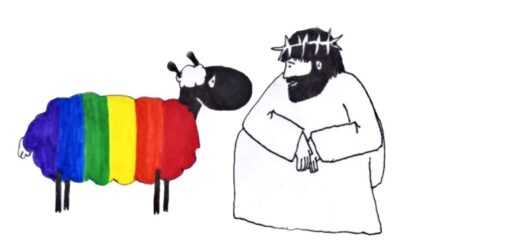Deconstructing the rule: the breaking of diversity in the conversion of the UNUCH ETIOPE
Text by Sean D. Burke*, published in Bible Trouble: Queer reading at the Boundaries of Biblical Scholarship**, edited by Teresa J. Hornsby and Ken Stone.
Publisher Society of Biblical Literature, Atlanta (United States), 2011, pp. 175-191.
Freely translated by the volunteers of the Gionata project
I focused on the history of the UNUCH ETIOPE in Acts of the Apostles 8: 26-40 initially for my interest in diversity and the way in which the communities, in particular Christian ones, manage the differences regarding the entry and participation in community life.
It seemed to me that the points where these multiple differences intersect were a particularly significant place to explore the way in which diversity is negotiated. ETIOPE eunuch embodies this intersection of multiple differences: gender, social status, race and, perhaps, even sexuality and religious identity.
If I initially interested myself in this story for the question of difference, what continued to capture my attention was ambiguity. Every time I tried to analyze a particular difference that the eunuch could represent, I came across an ambiguity.
In the history of interpretation, the eunuch has been read both as a man and as a castrated person. It is certainly different in terms of gender, but how can you identify its kind?
It was interpreted both as a high government official and like a slave. How to define its social status then? It was read both like a foreign Ethiopian and like a foreigner even for the Ethiopians themselves. How to determine its breed?
The biblical text can be used to support each of these readings, as well as multiple interpretations on the sexuality and religious identity of the UNUCO. How can an interpreter then confront all these ambiguity? Over the centuries, scholars have adopted at least four different approaches:
- Some have ignored ambiguity, interpreting the text as if every aspect of the identity of the UNUCO was clear and unique.
- Others have noticed ambiguity but concluded that they cannot be resolved.
- Some attempted to resolve ambiguity, trying to definitively establish every aspect of the identity of the Unucco.
- Finally, some argued that although every aspect of the identity of the UNUCO was clear in itself, the author of acts deliberately introduced ambiguity to serve for a historical, literary and/or theological purpose.
Queering and ambiguity in identity
The Queer (Queer Theory) theory offers a new and productive way of reading ambiguity in identity. One of the most important ideas of queer theorists is the idea that identity itself is a social construction produced through the speech.
In fact, the identity categories are not only a means of oppression, but also the basis of liberation movements. However, the queer theory insists that these categories remain arbitrary, regulatory and excluding. This is what makes their problematic naturalization and normalization, because these categories end up denying the difference and suppressing ambiguity.
On the basis of these intuitions, I define queering as the use of strategies to deconstruct and denaturalize identity categories.
The goal is not simply the deconstruction itself, but rather, as Judith Butler would say, create a space in which the more bodies can "count", that is, to be recognized as fully human. If identities are fluid social constructions, ambiguity must not be seen as problems to be solved, but as an opportunity for queering.
ETIOPE eunuch as a queer figure
The eunuch of acts 8: 26-40 has often been considered marginal in the story of acts, but a queer reading can demonstrate that its story is instead central. FF Bruce, for example, claimed that the UNUCH episode appears isolated, without any connection with what precedes or follows it.
However, reading the story through Lqueer shows that its story plays a fundamental role in the primitive Christian mission.
Furthermore, the queer interpretation of the history of the UNUCO questions the clear opposition between the subjects and the objects of the conversion. Acts does not tell only the story of the conversion of many to the faith in Jesus, but also of how the primitive Christian community itself has been transformed by its own ministry.
The first Christians had to be converted to the vision that baptism and communion in Christ did not depend on the identity of a person-Jew or kind, man or non-man, free or slave, citizen or foreigner.
This queer reading of the History of UNUCO invites us to review the categories of identity in contemporary Christian communities. In particular, they raise a crucial question: today's Christian communities need a continuous conversion to a "queer ministeriality" that can allow the spirit to be effused about all humanity, so that everyone can be saved?
* Sean D. Burke is associate professor of religious studies at the Luther College, Iowa. He achieved his doctorate in biblical studies at the Graduate Theological Union, specializing in New Testament and Queer theory. His studies focus on the interpretation of biblical texts through the lenses of queer and gender criticism.
** The collection of theological contributions "Bible Trouble: Queer reading at the Boundaries of Biblical Scholarship" (Society of Biblical Literature, 2011), edited by Teresa J. Hornsby and Ken Stone, explores the impact of queer theory in biblical studies. Through various interdisciplinary essays, the volume deconstructs the regulatory readings of the Scriptures, analyzing gender, sexuality and identity in biblical narratives. It shows how the Bible has been used to justify exclusions, but also how your Queer reading can offer alternative and more inclusive meanings.
Original text: Queering Early Christian Discourse: The Ethiopian Eunuch






